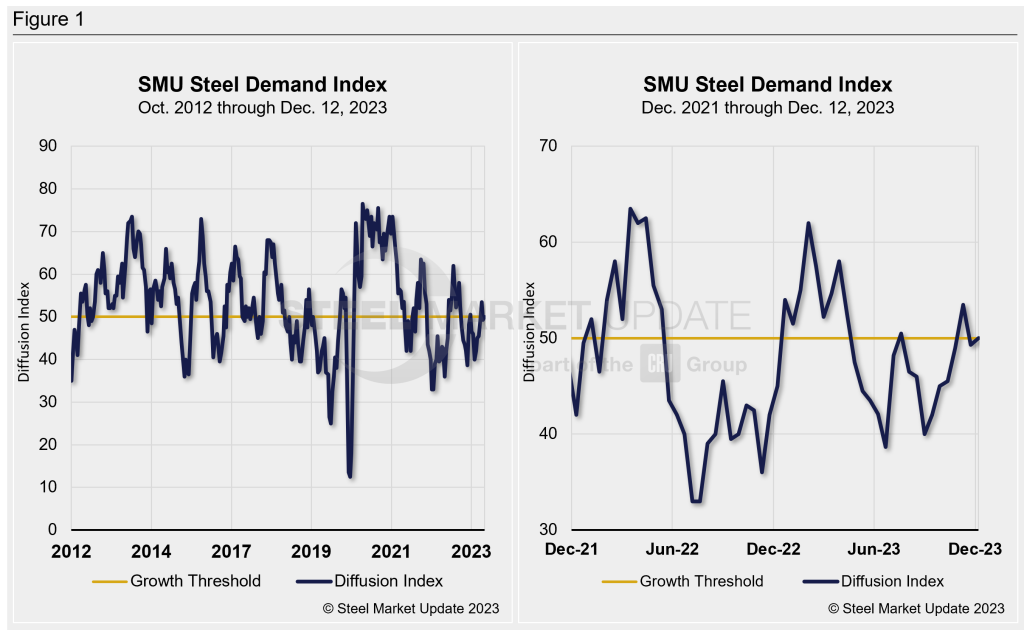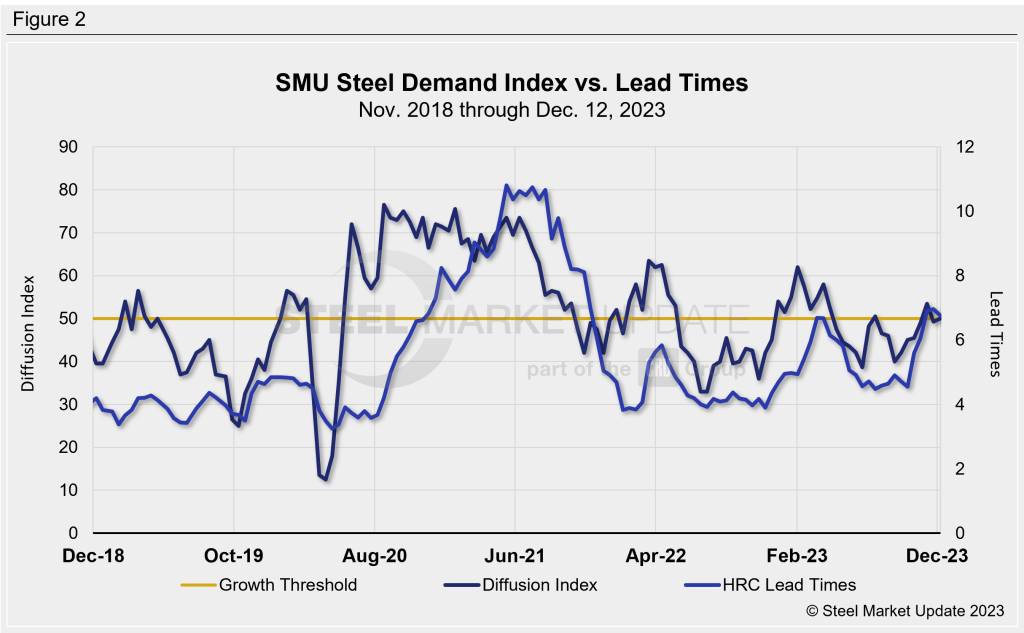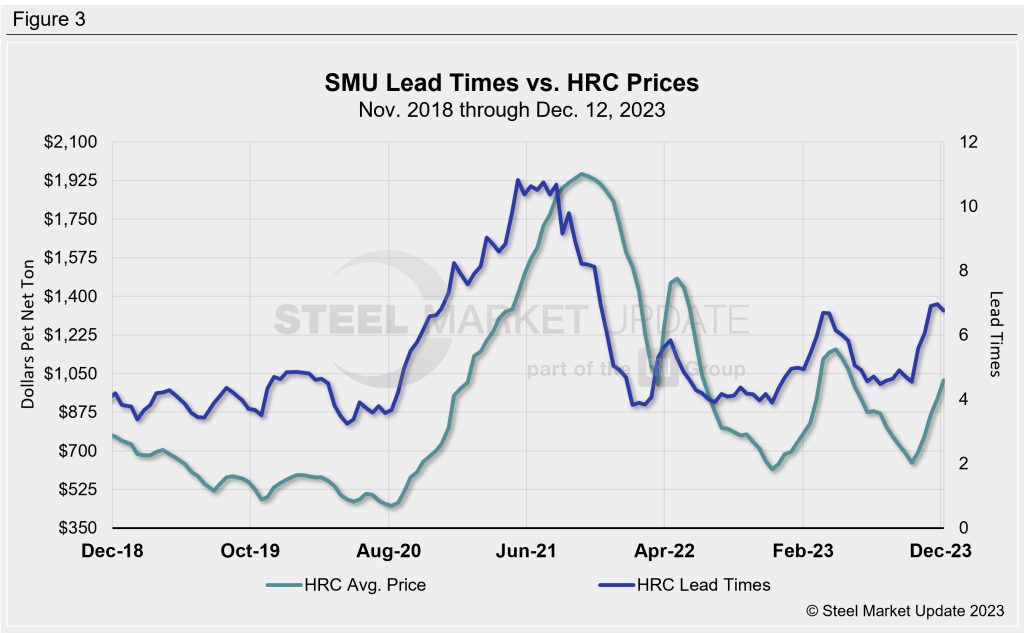SMU Data and Models

SMU steel demand index edges up
Written by David Schollaert
December 15, 2023
Steel Market Update’s Steel Demand Index has moved into growth territory, but barely, after recovering slightly from our reading in late November, according to our latest survey data.
The latest developments come on the heels of more mill price increases – still targeting $1,100 per ton base for hot-rolled coil. However, lead times have edged lower for the first time since September, and steel buyers have reported some willingness from mills to negotiate lower prices.
SMU’s Steel Demand Index now stands at 50, up just 0.7 points from a reading of 49.3 at the end of November. The measure has improved just marginally, but the move brings it up out of contraction territory.
The measure had improved by more than 13 points back on Nov. 9 after reaching a recent low of 40 back in late August. Interestingly, the only time the index has moved into growth territory since late April has been for short-lived bumps when the market responded to mill price hikes in mid-June and late September.
This could potentially be an indication that the bump in buying is still largely tied to buyers trying to get out ahead of mill increases rather than improved demand.
SMU’s Steel Demand Index has been largely trending downwards and in contraction territory since early April.
Methodology
The index, which compares lead times and demand, is a diffusion index derived from the market surveys we conduct every two weeks. This index has historically preceded lead times, which is notable given that lead times are often seen as a leading indicator of steel price moves.
An index score above 50 indicates rising demand and a score below 50 suggests declining demand. Detailed side by side in Figure 1 are both the historical views and the latest Steel Demand Index.

Current state of play
While overall market sentiment is still somewhat bullish, and while there is still talk of buyer resistance, weighing against it are higher input costs – scrap, pig iron, and iron ore.
SMU’s latest check of the market on Dec. 12 placed HRC at an average of $1,040 per ton ($52 per cwt) FOB mill, east of the Rockies, up $20 per ton vs. the prior week. Hot band is now up nearly $400 per ton since reaching the recent low of $645 per ton in late September.
With 2024 buying underway, and reports of a more watchful trend, it’s maybe no surprise that our demand index sits even as we approach the end of December.
I’m not going to speculate what comes next, but keep in mind that SMU’s demand diffusion index has, for nearly a decade, preceded moves in steel mill lead times (Figure 2), and SMU’s lead times have also been a leading indicator for flat-rolled steel prices, particularly HRC (Figure 3).


What to watch for
Lead times, keep a close eye on them. Our hot-rolled lead times averaged approximately 6.76 weeks this past week, down from 6.96 weeks in late November. While they have slipped from this year’s high, they’re above our earlier high of 6.69 weeks in mid-March. But is the latest shortening an indication of the slower holiday period or is the price rally running out of steam?
Note: Demand, lead times, and prices are based on the average data from manufacturers and steel service centers that participate in SMU’s market trends analysis surveys. Our demand and lead times do not predict prices but are leading indicators of overall market dynamics and potential pricing dynamics. Look to your mill rep for actual lead times and prices.

David Schollaert
Read more from David SchollaertLatest in SMU Data and Models

SMU’s June at a glance
A look at SMU data for the month of June.

SMU Survey: Buyers’ Sentiment rebounds from multi-year low
Both of SMU’s Steel Buyers’ Sentiment Indices edged higher this week. Current Sentiment rebounded from a near five-year low, while Future Sentiment rose to a two-month high

SMU flat-rolled market survey results now available
SMU’s latest steel buyers market survey results are now available on our website to all premium members.

SMU Survey: Sheet lead times pull back after early-June blip, plate holds
Following the uptick seen two weeks ago, lead times eased this week for all four sheet products tracked by SMU, while plate lead times held steady, according to this week’s market survey.

SMU Survey: Pricing power abruptly shifts to steel buyers
The majority of steel buyers responding to our latest market survey say domestic mills are more willing to talk price on sheet and plate products than they were earlier this month. Sheet negotiation rates rebounded across the board compared to early June, while our plate negotiation rate hit a full 100%.
